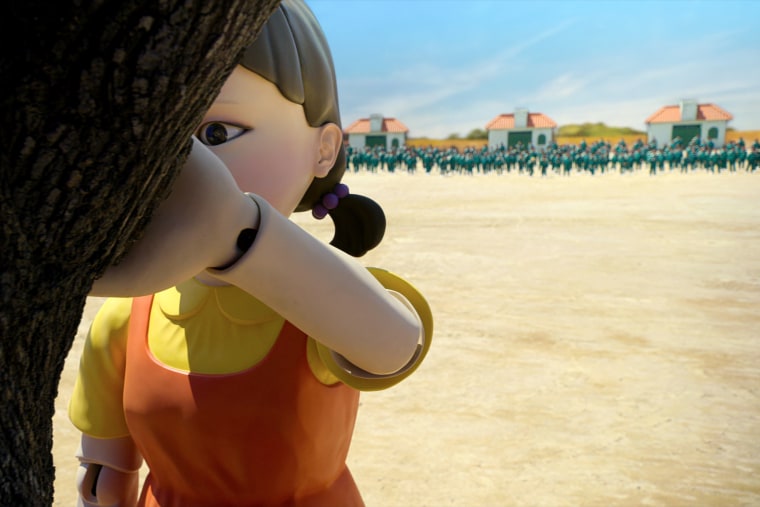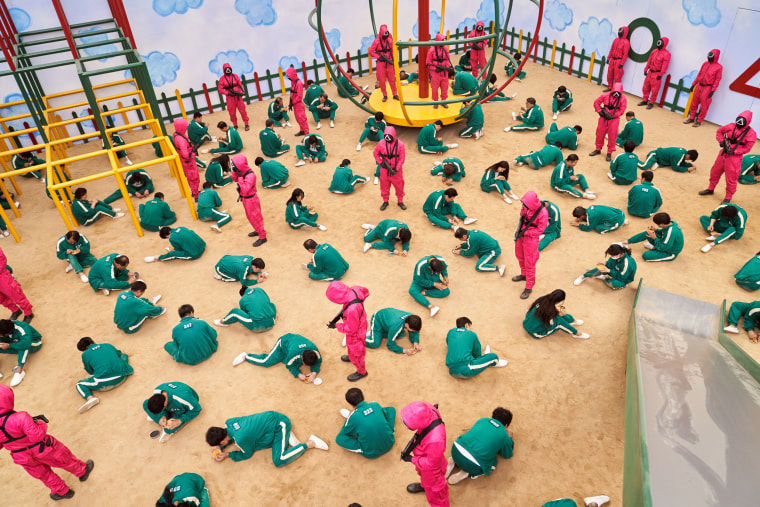In the South Korean hit show “Squid Game,” dark twists play out against a backdrop of childhood games. In the nine-episode Netflix series, 456 players fight to the death in a series of games for a cash reward of $38 million. The show mixes deeply entrenched issues of poverty, class anxiety and income inequality with nostalgic Korean childhood pastimes. Some of the scenes have sparked global interest in the traditional folk games on the show, and experts share some background below.
The Mugunghwa flower has blossomed, or Red Light, Green Light
In episode one, the players participate in a version of the game Red Light, Green Light. A giant robot doll, modeled after Cheolsoo and Younghee — children's characters in Korean textbooks — allows players to move only when they hear her singsong voice saying “Mugunghwa flower has blossomed”; otherwise they are shot. The rhythmic folk game has different variations, substituting "mugunghwa flower" with other words. Mugunghwa, or the rose of Sharon, is Korea’s national flower and is also in the country’s national anthem.

“The flower is particularly significant for the once-colonized Koreans because it blooms and blooms, seemingly forever,” said Chan E. Park, a professor emeritus at Ohio State University, referring to the country under Japanese colonial rule from 1910 to 1945. “Its symbolism is resilience — ‘Korea forever,’ so to speak.”
Dalgona challenge
In episode three, “The Man With the Umbrella,” players crouch over their dalgona, honeycomb-like flat candy made of melted sugar and baking soda, to pull out shapes like triangles, circles, stars and umbrellas. During the game, the show’s main character, Seong Gi-hun, repeatedly licks the candy from the back to detach an umbrella, which appears to be the most difficult shape to loosen. Writer and director Hwang Dong-hyuk said he used the same trick as a child.
The street food was most likely popularized in the 1950s to early '60s as a cheap snack substitute amid the struggling economy after the Korean War, when sugar was a rare commodity.

Removing the shapes from the candy was gamified and called “ppopgi” by Korean street vendors in the past, who offered a free bonus if children successfully pulled shapes from the toffee treat.
“Back then, sugar was very expensive, and general people could not get sugar,” said Dal Yong Jin, a professor and the director of the Transnational Culture and Digital Technology Lab at Simon Fraser University in Canada.
Park, 69, who spent her childhood in Seoul during the 1950s, said she remembers the snack being sold on the same street by the same ahjussi, or middle-age man. She described him as having a “tiny business installation of a few aluminum bowls and alcohol lamps cooking on a wooden apple crate, and children watching and waiting anxiously for their orders.”
Juldarigi, or Tug of War
Juldarigi, or Tug of War, appeared in episode four, “Stick to the Team,” in which the contestants were divided into 10-person teams.
The folk game was originally played as a Korean communal tradition to bind village communities and usher in bountiful harvests with distinct customs and rope styles depending on villages.
While the game was mostly played on Daeboreum, the first full moon of the Lunar New Year, other locals held the games based on various farming calendars.
“The most traditional game is juldarigi,” CedarBough T. Saeji, a folklorist and an assistant professor of Korean and East Asian Studies at Pusan National University, based in Busan, South Korea, said of the games played on the show. “It’s enormously connected to Korean heritage and there’s all this meaning going on here.”
Ddakji
The game ddakji appears in the first and final episodes. In the season finale, “One Lucky Day,” a mysterious recruiter-like salesman played by Gong Yoo tries to lure participants to the game by throwing red and blue envelopes to the ground and flipping their paper cards for cash.
Similar to American Pog played in the 1990s, players aim to turn over their opponent’s folded paper tiles, or ddakji, or “win” one if it passes a fixed line.
Yoo offers around $100 to the winners, but a slap if they lose and wish to continue playing without paying the penalty.
The game likely gained traction in the 1940s with an increased supply of paper, while folded ddakji became a staple children’s game as thick, durable paper spread after the Korean War.
Squid Game
Squid game is named after the squid-like diagram usually drawn on sandy fields. Players are separated into two teams, with attackers trying to reach and dominate a “land” or home base, usually hopping on one leg out of bounds, while offense players push, pull and try to keep their opponents outside the lines.
The game appears both in the first and last episodes, with the latter in stark contrast from the cheery game childhood friends Gi-hun and Sang-woo played when their moms would call them back home for dinner. In the season finale, the pair are the only two left in the match.
Young A. Jung, a professor at George Mason University, recalls her experiences with the game, saying, “My T-shirts were torn down many times when playing squid game and we would always argue to figure out whether the winner’s feet are all in the line or on the border.”
At a South Korean news conference for the show last month, director Hwang Dong-hyuk said he settled on “Squid Game” as the drama’s title based on his recollections and rendition of the sport.
“Squid Game was the most physically aggressive childhood game I played in neighborhood alleys as a kid, which is why I also loved it the most,” Hwang said. “In a way, it’s the most symbolic game that reflects today’s competitive society, so I picked it out as the show’s title.”
